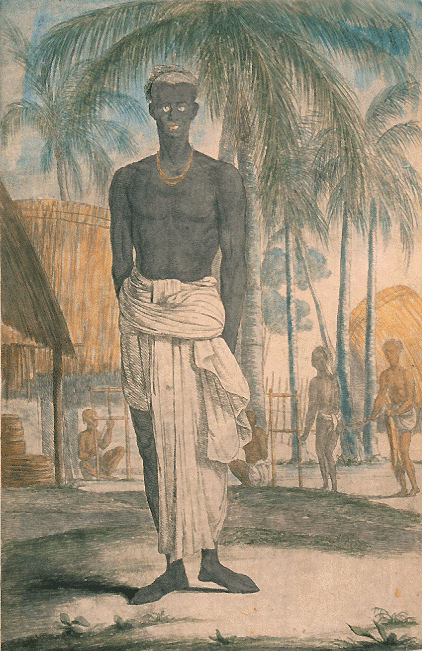The Caste System in Bengal, Part 2
BY: SUN STAFF

Solvyns, Hand-colored Engraving, Calcutta Series
Jan 24, CANADA (SUN) — A three-part series on the varnasrama system in Bengal, with a pictorial study of the various varnas and asramas.
The non-brahmins in Bengal were almost all formally classified as being in from 36 to 41 subcastes of sudras, in three categories. The exact enumeration varies somewhat, but the list in Vrhaddharma Purana is presented here as an example. The top subcaste (from whom the brahmins can drink water, and for whom they can be priests) consist of the following. (Links have been provided to images representing many of these varnas, from the Calcutta Engravings series by Solvyns, c. 1799.)
Record keepers (karana or kayastha). Karana seems to become less prevalent with time, kayastha more, though there are exceptions. Doctors and medicine makers (ambastha or vaidya). Doctors in the early part are being described as karana. In South India, some doctors were also brahmins. In Bihara, one can also find the ambastha kayastha caste, said to be descendants of Citragupta and zobhavati. In Bengal, ambasthas seem to merge into vaidyas, fighters (ugra), envoys and messengers (magadha), weavers (tantuvaya), scent traders (gandhikavanika), barbers (napita), writers (gopa), ironsmiths (karmakara), betelnut traders (taulika), potters (kumbhakara), brass smiths (kamsakara), conch smiths (shagkhika), farmers (dasa), betel leaf farmers (varujivi), sweetmeat makers (modaka), florists (malakara), praise singers (suta), rajaputra, and betel leaf traders (tambuli).
Some of these people, the kayastha/vaidyas (these terms have since taken much broader meanings) often call themselves, in accord with the stories of their origin as found in, for example, Brahmavaivarta Purana, ksatriyas or vaisyas may be closely tied to the origins of the brahmins.
Manu also describes the origins of many of these, as arising out of violation of caste rules. Thus, ambasthas of brahmana father and vaisya mother (two degrees apart is not considered proper), karanas of some ksatriyas who had given up his duties. As a result, some of them consider themselves Vaidya Brahmins (and use both the vaisya indicator gupta and brahmana indicator Sharma. Like the non-sudra castes in ancient texts, they have limited rights to the Veda and sacred thread ceremony.
The Kayasthas divide themseves into the uttararadhis, the daksinaradhis, and the vamgajas. The daksinaradhis include the kullna ghosa, basus, and the mitras and the maulikas, who divide themselves as the upper dey, datta, kar, palit, sena, simha, dasa, and guha, and the lower seventy-two. Among the vavgajas the guha are the only kullnas.
The middle subcaste consisted of engravers (taksana), washermen (rajaka), goldsmiths (svarnakara), gold traders (svarnavanika), milkmen and cowherds (abhira), oil traders (tailakaraka), fish traders (dhivara), alcohol traders (shaundika), actors and magicians (nata), descendants of Buddhist leaders (shekhara), fishermen (jalika; possibly, buffalo keepers arose from these later) and another unidentifiable category, shabaka.
The lowest subcaste (considered untouchables) consist of cleaners (malegrahi), those that cremate the dead (candala), carpenters (taksa), leatherworker (carmakara), boatmen (ghattajivi), chairbearers (dolavahi), wrestlers (malla) and two unidentified groups (varuda and kudava). In addition are desribed the mleccha or foreign groups like pukkasha, pulinda, khasa, thara, kamboja, yavana, sumha, shavara, etc., who were left outside the entire classification.
In contrast, , Brahmavaivarta Purana mentions the top subcaste, exemplified by gopa, napita, bhilla, modaka, kuvara, tambuli, svarnakara (later demoted), and vanika; followed by karana and ambastha.
Then of the nine sons of Vishvakarma by a sudra: maiakara, karmahara, shagkhakara, kuvindaka, kumbhakara, and kamsakara are explained as being high, while sutradhara and citrakara were also demoted. Suvarnavanika is also demoted because of association with svarnakara.
After this there is a long list of fallen subcastes, including attalikakara, kotaka, tivara, tailakara, leta, malla, carmakara, shundi, paundraka, mamsaccheda, rajaputra, kaivarta, rajaka, kauall, gaggaputra, and yuggi. The really low subcastes included vyadha, bhada, kola, kojca, haddi, doma, jola, vagatata, vyalagrahi, and candala.
Traditional stories try to explain the bizarre patterns found in these variously shifting castes. For example, the goldsmiths claimed they were vaishyas who were insulted by Vallalasena, who invited and placed them with the satsudras at dinner, and who furthermore borrowed a lot of money by force. When they tried to revolt against him, he lowered their status; and he further disallowed wearing of the sacred thread by traders. Overall, however, the low position of the artisan class fit well with the agrarian turn at the beginning of the Pala period.
Excerpted from A Short History of Bengal, by Tanmoy

The Sun
News
Editorials
Features
Sun Blogs
Classifieds
Events
Recipes
PodCasts
About
Submit an Article
Contact Us
Advertise
HareKrsna.com
Copyright 2005, HareKrsna.com. All rights reserved.
